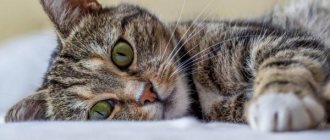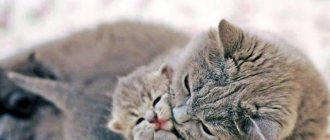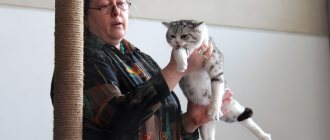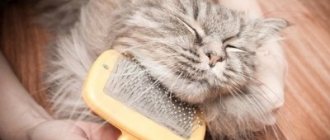A little about the dream itself
Science has been studying cat dreams since the middle of the last century. Judging by the data from devices connected to sleeping purrs, they are in many ways similar to their owners. Scientific research has shown that even when a cat is resting, the brain continues to work actively, almost the same as during wakefulness. Not a single animal can refuse sleep, otherwise it will be impossible to restore energy expenditure.
Cats sleep 15-18 hours a day.
The following sleep phases are distinguished:
- Superficial (fast). At this time, the body is just preparing for rest. But any irritant can provoke activity. The duration of the period is 10-15 minutes. At the same time, muscle tone is preserved, the animal remains tense.
- Deep (slow). During this period, the muscles relax, the body of the purr becomes limp. The eyes are closed, the movement of the eyeballs is noticeable. This is a sign that the animal is dreaming.
Cat sleep is in many ways similar to human sleep.
When an external stimulus appears, for example, noise, a cat that is in a deep phase will wake up, but it will not be able to immediately get up and run. Awakening happens slowly. Usually at this time the cats stretch and begin to wash themselves.
The French scientist Michel Jouvet managed to uncover the secret of cat dreams during an experiment conducted in 1979. When the body sleeps, the ability of the muscles to move is turned off by the brain in its special department. Scientists invaded this program and stopped this shutdown of movements in the experimental cat. As a result, the purr literally became a sleepwalker. During the deep phase the cat was motionless, but during the fast phase he moved, hunting for someone, not paying attention to the real mouse offered. This suggests that cats are capable of experiencing joy, sadness, anxiety and other emotions in their dreams.
You should respect your pet's rest. Just like a person, when a furry suddenly awakens, his heartbeat quickens and he gets scared.
Do cats dream?
Scientists have always wondered whether cats dream. Much research and experimentation has been carried out to measure the brain activity of our little brothers and their general state during sleep and wakefulness.
It was interesting that in a dream the same impulses emanate from cats as during wakefulness. Their brains continue to work actively. That is, judging by the high brain activity, it seems that meowing pets are not sleeping at all. In fact, this opinion is wrong. Every living creature is designed in such a way that it simply needs sound sleep for the normal functioning of the whole organism.
The fewer brain convolutions, the less need for such rest arises. The deep sleep phase is also called the REM phase. Scientists have found that fish do not have such phases. In birds they last a couple of minutes. In rats, the REM phase lasts half an hour a day. In humans, generally from one to two hours a day. And only the cat had the longest stay in this sleep phase. This takes about three hours a day.
What such dreams are like in general is still unknown to anyone. But scientists have come to the same conclusion that a person without such sleep begins to suffer from mental disorders.
Anyone can make sure that a cat dreams. You just have to take a close look at your pet while he is resting. At the same time, the animal’s eyes seem to be closed, but under the eyelids their constant movement is observed. Of course, no one will probably ever know what kind of dreams cats have. One can only guess and fantasize about this. If a cat twitches its paw, moves its ears, whiskers or tail in its sleep, most likely pictures from its everyday life are floating before its eyes. At the same time, the body is completely relaxed.
It has also been noted that animals living in different environments have different ways of being in the deep phase. Barn cats, for example, sleep less, because they need to constantly check their territory and chase mice. And well-groomed pets, who do not need anything, often indulge in the two most important activities in their lives - eating all kinds of delicious food and sleeping.
A cat's sleep also directly depends on its age. Small kittens, for example, sleep 12 hours a day. And without dreams. Already after 1 month of life, they begin the slow-wave sleep phase, and at three months, a kitten’s sleep becomes similar to the sleep of an adult cat.
These animals most often do not suffer from sleep problems. But if for some reason the animal was deprived of deep sleep, it becomes aggressive and irritable. If your pet sleeps longer than usual, there is some good reason for this. Perhaps the room is very hot, the cat is pregnant, or moving to a new place has caused stress in the animal. But if all these reasons are not present, and the pet sleeps most of the time, perhaps some disease is bothering him. You should definitely take a closer look at the animal and, if necessary, seek help from a good veterinarian.
Similar articles:
- Cats are healers
- Lifespan of cats
- Why are people afraid of black cats?
- How to get rid of cat smell
- Why cats love boxes
- How to choose a kitten
Do cats dream?
As a result of observations and research, scientists have come to the conclusion that cats really dream. But what exactly they dream about remains a mystery. The assumptions can be anything, from hunting mice to playing with other animals.
The age of the animal influences dreams. Kittens under the age of 1 month are deprived of dreams, and they sleep much less than adult pets - about 12 hours. The deep phase occurs in older cats. Full-fledged dreams appear in purring cats that have reached the age of three months. Adult pets doze more than sleep soundly. At this time, they are able to react sensitively to external stimuli and do not dream.
It is impossible to say what kind of picture the purrs see - color or black and white. Moreover, cats’ vision differs from that of humans, and they see the world somewhat differently. It is believed that active, emotional pets can see colorful dreams.
Kittens under the age of 1 month are deprived of dreams. Adult pets often doze. In the deep phase of sleep, the cat is motionless.
Why does a cat dream at night - features of deep rest
This sleep phase is accompanied by a change in the nature of the pet’s brain activity:
- increased body temperature;
- mild tachycardia;
- slight increase in pressure.
This is the answer to the question “why does a cat dream at night?” Despite these obvious similarities to human sleep, deep rest in a cat is somewhat different. Their brain doesn't sleep.
Why can cats defend themselves even when they are dreaming at night? It's all about instincts, in particular self-preservation. It allows the animal to react to sudden changes and defend itself earlier than a human.
Do cats have nightmares?
You can often notice that a sleeping pet twitches its tail and paws, hisses, and scratches an invisible victim. This behavior makes it possible to claim that the cat sees something to which it reacts negatively. Apparently the animal is having a nightmare.
If your furry dog often becomes restless while sleeping, you should contact a veterinary clinic and have it examined. Sometimes this behavior can be caused by head injuries or the development of tumors.
Cat sleep is in many ways similar to human sleep. And the socialization of animals made them even more similar to people. The area of sleep still remains unknown in many aspects, but the fact that cats dream is beyond doubt.
Recommended Posts
Standard height and weight of the Cane Corso breed by month
Weight of a puppy and an adult Labrador by month
Weight and height of a German Shepherd puppy by month
TOP 40 best hunting dog breeds with names, descriptions and photos
38 best dog breeds for apartments according to reviews from breeders and owners
Why cats can’t fish and the dangers of having too much of it in their diet
Why do cats dream: Vanga’s dream book
Cats and kittens are pets that bring joy and decorate life. But, according to Vanga, seeing a cat in a dream is not the best omen. It can portend quarrels, dangers and conflicts. This is what the soothsayer says:
- Even if you have an unremarkable dream in which a cat appears briefly, this is an alarming sign. You need to be attentive and careful to avoid trouble.
- When you see a flock of cats, you should prepare for intrigues from your enemies, the dream book says. A cat that has bitten or scratched the dreamer means almost guaranteed problems, possible quarrels and outbursts of jealousy.
- Are you wondering why kittens dream? If a woman dreams of a white fluffy kitten, she may fall into a trap and face difficulties. Hungry, dirty kittens mean deception, and if there were a lot of these animals in the dream, adversity will follow one after another.
- Trouble can be brought, as the dream book describes, by a gray cat. At the same time, the dreamer will create problems for himself due to rashness and inattention.
Experiments
The most revealing experiment in this regard was the experiment of a certain Penny Patterson, who studied the functions of the brain of higher primates. Specifically, two gorillas. In the process, a special communication system was developed that made it clear what exactly the monkey sees, remembers and feels. Everything is as simple as possible and does not allow for double interpretation. The primitive sign language that chimpanzees learned at one time, only even simpler.
So, immediately after waking up, the gorillas demonstrated knowledge or memories about people they had not seen for a long time and about events that had not happened to them. What are these if not dreams? Moreover, one monkey, which had suffered serious psychotrauma in the past - an attack by poachers, had absolutely full-fledged nightmares. And gorillas are still very primitive primates.
But the brains of cats and dogs are even simpler - is it possible to determine what exactly they are dreaming about? Unfortunately, such a communication system does not yet exist, so researchers can only speculate. Including based on the nature of movement and sounds made. In particular, a certain Michel Jouvet, in the process of studying the sleep of cats, came to the conclusion that they mainly hunt.
As for dogs that develop a strong emotional attachment to their owner, it is quite possible to assume that they dream about him and the pleasant events associated with him. Alas, how to test this in practice is absolutely unclear.
The Joinfo.ua team and journalist Artem Kostin remind you that animals are not as simple and primitive as they seem. It is only from the outside that one gets the impression that they are all the same. In fact, each of them has its own special character. But can they be considered full-fledged individuals? Ethicists do not yet have a consensus on this matter. Including because even cows and goats show signs of intelligence and character.
Two phases of sleep in cats
Modern scientists have all the capabilities to determine the physiological characteristics of cat sleep. They found that sleep in our furry pets is divided into two completely different types.
The first type of sleep is shallow sleep, more like a nap. It is called low-wave sleep or slow-wave sleep. You can easily notice it in your pet when he sleeps, curled up, but is sensitive to all extraneous sounds and sudden touches. At any moment of low-wave sleep, a cat can wake up, and very, very quickly.
During low-wave sleep, a cat's muscles are tense, but breathing and pulse are slow and uniform. In addition, the cat's temperature and blood pressure drop and metabolic activity decreases. In a word, in its characteristics this phase is very similar to sleep, but in essence it is closer to drowsiness.
The second type of sleep is deep sleep, called rapid eye movement or REM sleep. Indeed, at this time, a cat’s eyes, like a person’s, rotate very quickly behind closed eyelids. This sleep occurs 10-30 minutes after the start of low-wave sleep.
This phase is also special. The sleep is really deep, so much so that the cat loses control over its muscles and may inadvertently fall from a chair or sofa if it is not very comfortable. During deep sleep, a cat can greatly change its body position without waking up.
But here's what's surprising! The cat is undoubtedly sleeping, but from a physiological point of view it is no less active than when awake. Scientists have found that during deep sleep, brain activity is no lower than when a cat is eating, playing or hunting, and maybe even higher. Breathing is uneven, pulse and blood pressure are also uneven.
So, the first phase of sleep is characterized by reduced activity, but lack of depth, and the second – by high activity and depth. If you sharply touch a cat during a deep phase of sleep or arouse it in another way, it will wake up much slower than after low-wave sleep - scientists say that the speed of exiting the deep phase is as much as 300 times slower!
What does it mean if you dreamed of a cat: Freud's dream book
Freud interprets dreams through the prism of psychoanalysis. Therefore, when you dream of a cat, the dream is associated with the sensory sphere and is a signal from the subconscious. You can more accurately understand its meaning by what happened in the dream:
- If you dream of a cat that caresses and purrs, in reality a person lacks physical contact and affection.
- If the dreamer strokes a cat, most likely, he subconsciously strives for tenderness.
- For those who want to understand why they dream of a cat that is big and attracts attention, Freud gives the following answer: a very difficult situation is possible in the future. Therefore, you should remain calm, sane and make informed decisions.
White cat in autumn: pixabay.com











